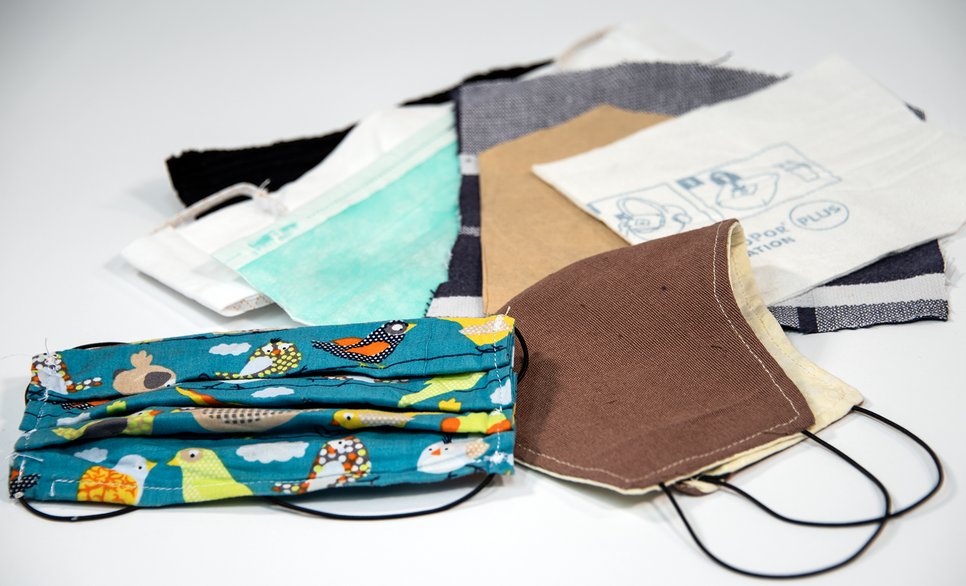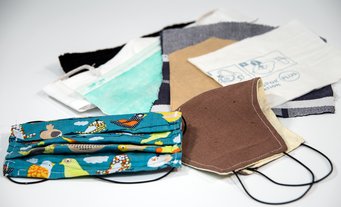Fighting the coronavirus with fabric and paper towels
There are many common household materials which block particles and droplets, and which can reduce the risk of infection from the coronavirus
Masks are already compulsory in Austrian supermarkets, and the German National Academy of Natural Sciences Leopoldina also recommends a mask - even a hand-made one - over the nose and mouth to protect against SARS-CoV-2. Researchers at the Max Planck Institute for Chemistry have now tested various household fabrics alongside surgical masks, to determine how well they filter particles from the air. They found that all the materials tested, including cotton fabrics, kitchen roll and vacuum cleaner bags, capture the vast majority of particles a few micrometres in size. The results apply readily to droplets - the most common method of transmission of the virus. However, not every material tested can be recommended for face masks.

Any of the fabrics that the Mainz researchers tested as filter material can be found in each household. In addition to cotton and paper towels, they also tested materials such as microfibre cloths, coffee filters and non-woven vacuum cleaner bags for their ability to screen out particles and potentially infectious droplets.
“We found that all the materials we investigated were very efficient at screening out particularly large particles of five micrometres or larger. Their efficiency was mostly 90 percent or more,” says Frank Drewnick, Research Group Leader at the Department of Particle Chemistry. The fabrics could therefore capture the majority of droplets which play the biggest role in coronavirus infection, since - according to all our current knowledge - these droplets are significantly larger than a few micrometres.
The filtering effect is also dependent on the speed of air flow
However, the investigation also revealed that for particles smaller than 2.5 micrometres, the filtering effect is heavily dependent on the filter material used, often reaching a minimum at between 100 and 500 nanometres. For example, it became apparent that microfibre cloths are less efficient at keeping particles of this size at bay than vacuum cleaner filter fabric, or a combination of cotton and flannelette. Several materials put together are better at capturing even the smaller particles. The SARS-CoV-2 virus is around 100 nanometres in size. However, according to studies, it is transmitted in substantially larger droplets from sneezing, coughing or talking.
The efficiency of a filter in screening out particles depends not only on the particle size, but also on the electrical charge of both the particles and the filter fibres, as well as the speed of air flow through the material.
However, the face-mask fabric must not only efficiently block particles and droplets, it also needs to be skin-tolerant and must not contain any other toxic ingredients. The Mainz researchers have not investigated the latter, but vacuum cleaner bags, for example, may contain biocides. The ease of breathing through the material is also important. To test this, the atmosphere researchers measured the drop in pressure of air passing through the filter fabric. Ideally it needs to be low, while retaining a strong filtering effect. The tests revealed slightly worse pressure reduction values in dual-layer firm cotton fabric or a combination of vacuum cleaner bag material and cotton fabric compared with professional surgical masks or a combination of jersey and flannelette. A coffee filter, although it screens out larger particles very well, has very low air permeability, so is not particularly practical.
The way a mask is used is crucial
“Our data make no statement on the actual level of protection a face mask offers. They may however help in choosing suitable filter materials for hand-made masks,” says Frank Drewnick; he hopes to test further materials and investigate larger sample tests. He stresses that the effectiveness of a mask depends on a number of factors. It is not only correct usage that is crucial: the proportion of air actually flowing through the mask, or through an air gap between mask and face, and the frequency and method of washing the mask are also vital factors.
For their investigation into which commonplace materials might be suitable for sewing face masks, Frank Drewnick and his team quickly repurposed some measuring instruments normally used for analysing the properties of atmospheric aerosol particles. “It quickly became clear that our measuring techniques and methods of particle generation, which we normally use for completely different purposes, are ideally suited for investigating filters and filter materials in the laboratory,” says Stephan Borrmann, Director of the Department of Particle Chemistry at the Max Planck Institute for Chemistry. Thus, the series of tests of the Mainz researchers make a thoroughly practical contribution to overcoming the Corona epidemic.
The measurement results and details of the setup are linked as PDF on the left side of this text and will be updated when new results are available. Please note that the results are available in German only.
